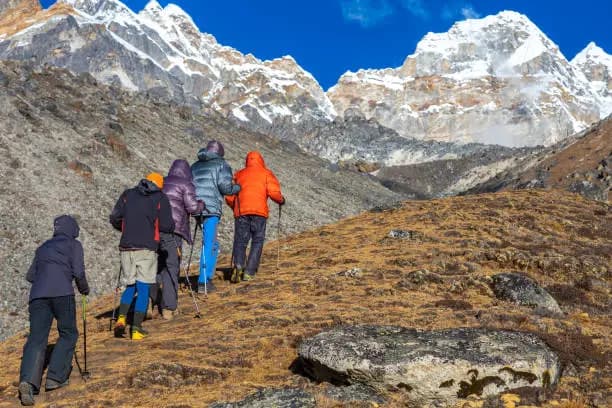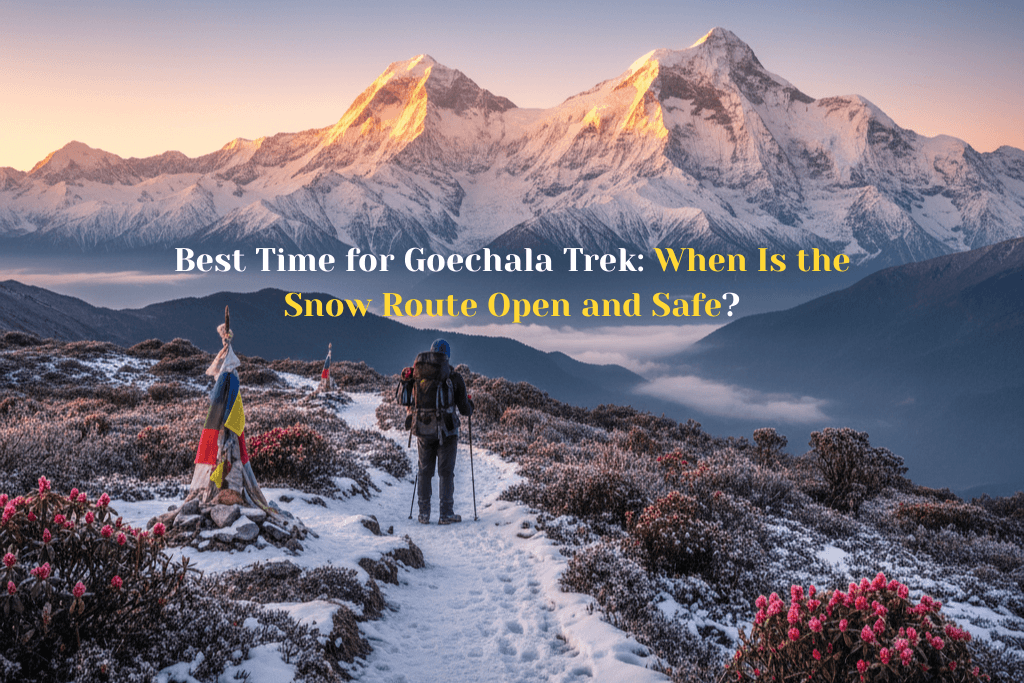Goechala trek is a very famous Indian trekking trail. It is located in the centre of the Himalaya Sikkim. Individuals are aware that this is one of the most scenic climbs with sweeping views of the third tallest mountain in the world, the Kanchenjunga along with other peaks such as the Pandim, Jannu and Simvo. The Goechala Trek is highly recommended and hikers ought to complete it once in their lifetime due to the fact that this trail takes one through forests and alpine meads, as well as high-altitude passes. Goechala Trek is a great trek that people who have hiked before and those who have never hiked can go on. The entire arrangement will take you along the entire path and give you tips, reviews, and other relevant information to enable you to plan your walk well.
Why Choose Goechala Trek?
The Goechala journey has a lot of great things about it that make it a great journey for both nature lovers and adventure seekers. This is why this trek is so popular with trekkers:
- Stunning Views of Kanchenjunga: The Goechala journey has a lot of great things about it that make it a great journey for both nature lovers and adventure seekers. This is why this trek is so popular with trekkers:
- Biodiversity: The hike leads you through beautiful oak, rhododendron, and magnolia forests that are home to many animals, including the red panda and many kinds of birds.
- Alpine Terrain: Goechala trek is memorable because you trek in meadows, glaciers and valleys at very high altitude.
- Diverse Cultural Exposure: Trekkers even have interactions with the friendly locals and come to know their unique culture while moving through the Sikkimese villages.
Goechala Trek Itinerary
Goechala Trek typically takes over ten days. This properly planned vacation will allow the hikers to acclimatize to the higher ranges of the altitude and to enjoy their surroundings.
| Day | Trek Destination | Altitude | Trekking Duration | Highlights |
| Day 1 | Yuksom to Tsokha | 2,900 m | 5-6 hours | Easy trek through dense forests; views of Kanchenjunga. |
| Day 2 | Tsokha to Dzongri | 4,030 m | 5-6 hours | Rough climb with a view of the Mt. Pandim and Kanchenjunga. |
| Day 3 | Dzongri to Thangsing | 3,950 m | 5 hours | Good glaciers and snow verge on mountain views. |
| Day 4 | Thangsing to Lamune | 4,000 m | 5-6 hours | Trek through alpine meadows and ridges. |
| Day 5 | Lamune to Goechala | 4,940 m | 7-8 hours | Reaching Goechala Pass; 360 degree view of Kanchenjunga. |
| Day 6 | Goechala to Lamune | 4,000 m | 4-5 hours | Return trek; scenic views of the Himalayas. |
| Day 7 | Lamune to Thangsing | 3,950 m | 4-5 hours | Relaxed descent with stunning views of the surrounding peaks. |
| Day 8 | Thangsing to Dzongri | 4,030 m | 4-5 hours | Descent with beautiful forest landscapes. |
| Day 9 | Dzongri to Tsokha | 2,900 m | 3-4 hours | Return to Tsokha; enjoy the pristine beauty of the forests. |
| Day 10 | Tsokha to Yuksom | 1,780 m | 5-6 hours | Final descent back to Yuksom, completing the trek. |
Key Highlights of Goechala Trek
The Goechala Trek has more to offer than just beautiful views. Here are some of the most important things of the trek:
1. Panoramic Views
Trekkers have the opportunity of viewing the Kanchenjunga Range consisting of Kanchenjunga, Pandim, Jannu, and Simvo in such a manner that nowhere is possible, when they start climbing Goechala pass. These mountains are covered by snow and the view at sunset and sunrise is simply a beautiful background.
2. Biodiversity of the Region
The hike is a great place for anyone who appreciates the environment and wildlife. You will go through Kanchendzonga National Park, which is a UNESCO World Heritage Site. This park is home to many different animals, including the red panda, snow leopard, and blue sheep. There are rhododendron and magnolia trees in the thick forests.
3. Diverse Terrain
The trail leads you across a lot of various kinds of land, such as dense forests, alpine meadows, glacial lakes. The change in landscapes ensures that every day of the walk is epitomized as new and interesting.
Important Tips for Goechala Trek
1. Physical Preparation
The Goechala Trek is not very exhaustive and the trekking advisable is that one has to get ready to trek the high altitude and inclined tracks. The training ought to comprise:
- Cardio Exercises: Do things like running, biking, or swimming to build up your stamina.
- Strength Training: You have to be fittest to have hills, so perform on stronger showing in your legs, primary and upper body.
- Acclimatization: Get there a day or two early to get adjusted to the high altitude, especially because the hike goes up a lot.
2. Necessary Trekking Gear
It’s important to pack the correct stuff for a comfortable hike. Check out this list of the items you need for the Goechala Trek:
| Essential Gear | Purpose |
| Trekking Boots | Waterproof, sturdy boots for rough terrains |
| Layered Clothing | Keep warm with thermal wear and windproof jackets |
| Backpack with Rain Cover | To carry essentials and protect from rain |
| Trekking Poles | To support your knees during steep climbs |
| Headlamp & Extra Batteries | For early morning or late evening treks |
3. Altitude Sickness
When you hike at high altitudes, especially above 3,500 meters, you are likely to have altitude sickness. Make sure to:
- Hydrate well throughout the trek.
- Avoid overexertion on the first day of the trek.
- Rest frequently and seek medical attention if you experience severe symptoms of altitude sickness.
4. Guide and Permits
It is best to hike with a guide, especially in the parts of the walk that are hard to get to. You also need special licenses to access the national park for the Goechala journey. You can get these permits at Yuksom before you start the journey.
Reviews from Trekkers
People from all around the world have given the Goechala Trek great praise. Here are some things that trekkers have pointed out:
- Stunning Views: Many people who hiked said that the best part of the walk was the views from the Goechala Pass. People said that the views of Kanchenjunga at sunrise were “breathtaking” and “once in a lifetime.”
- Challenging yet Rewarding: It is proven to be tough on body but those who embark on the trek say it is very gratifying when one gets to reach the peak. No such feeling can be compared with the one that you feel after going past the Goechala Pass.
- Amazing Culture: People who went trekking also liked meeting people from the Sikkimese communities in Yuksom and Tsokha and learning about their way of life and culture.
Conclusion
Goechala Trek is indeed, one of the most iconic and tough treks in India. Not only does it provide trekkers the chance to traverse a wide range of landscapes but also enables them to immerse themselves with local cultures and most prominently view the majestic Kanchenjunga in its actual presence. Although the hike necessitates some form of physical exercises, apt preparation, and knowledge of those requisite items and precautions, the adventure is completely worthwhile. The Goechala Trek whether you are an expert trekker or a first-time traveller will give you a lifetime to remember.
FAQ
Q: What is the best time to do the Goechala Trek?
A: The best time to trek to Goechala is before and after the monsoon, i.e., between March and end of May and again between the start of September to November. The climate in this period is favorable for trekking to Naples Italy as clear summery weather with mild temperatures is common.
Q: How difficult is the Goechala Trek?
A: The Goechala Trek is not too hard, but it is hard. It takes a lot of fitness and stamina, especially for the climbs at high altitudes.
Q: Can beginners attempt the Goechala Trek?
A: If you’re in decent shape, beginners can try the Goechala Trek. Before doing Goechala, it’s a good idea to train ahead of time and maybe even do a few shorter treks.Q: What is the altitude of the Goechala Pass?
A: The Goechala Pass is 4,940 meters (16,210 ft) high.















